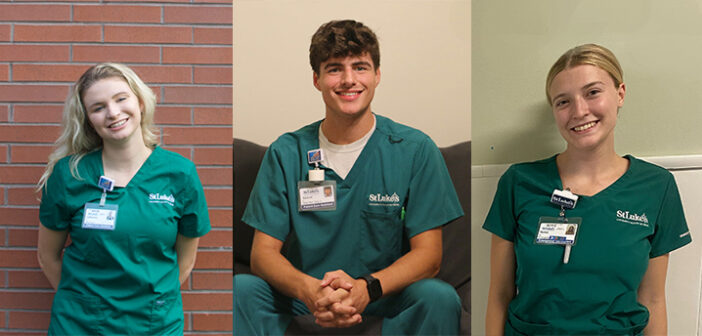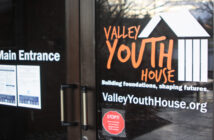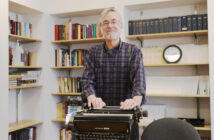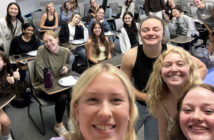Quinn Klessel, ‘24, has gained the ability to predict the split-second decisions of doctors around her.
Catherine Kelly, ‘25, went from being an inquisitive bystander learning about patient care to an active medical employee.
And Sam Jones, ‘25, builds rapports with the patients he works with and has even received letters of gratitude for his hospitality.
With St. Luke’s University Hospital less than a mile from Lehigh’s campus, students like these, who hope to pursue careers in medical or health fields, decide to become volunteers or employees there.
Lehigh University doesn’t have a medical school but does have a pre-health track, so the close proximity of St. Luke’s provides ways for students to get tangible medical experience.
Autumn Moser, associate director in the Center for Career and Professional Development, said along with opportunities at St. Luke’s, students can also choose to volunteer for Lehigh EMS to see what it is like to be an EMT, as well as experience what it is like to go on call.
She said students can figure out fairly quickly if emergency medicine is for them or not, if they want to, the organization can help them become certified wherever is convenient for them.
Klessel, a behavioral neuroscience major and health, medicine and society minor, said she started volunteering at St. Luke’s in the emergency department in January 2021.
This eventually led her to work as an emergency department technician in February 2023. Here, she has learned details about specific medical devices, which she thinks will help her in future work.
“It’s just been an incredible learning experience all around,” Klessel said. “I feel like I’m a step ahead because I know the slang — I know the terms that they use.”
She said conversing with doctors and asking them questions has helped her prepare for emergency situations.
Kelly is also a behavioral neuroscience major, and she volunteered at St. Luke’s for a few months before becoming an employee.
As a volunteer in the ambulatory surgery department, she said she learned about the role of a patient care assistant and later applied for a job as one.
“I thought it would be a better way to get more hands-on clinical experience before medical school,” Kelly said.
Kelly said the work for volunteers is more hands-off, with little patient interaction. However, as a patient care assistant, Kelly said there are more hands-on responsibilities such as taking blood work and vital signs and providing patients with basic comfort and care.
As much as learning in a classroom environment can prepare students for their future, Klessel, Kelly and Jones share the sentiment that St. Luke’s provides undergraduate students with the firsthand experience they are missing in the classroom.
Jones is another behavioral neuroscience major and health, medicine and society minor. He said interacting with patients and becoming accustomed to the healthcare team model has had the biggest impact on him as he gains experience before medical school.
He started working as a patient care assistant last May, hoping to gain the knowledge and experience of what it is like to work in a hospital.
Jones said he had an unforgettable experience at St. Luke’s when one day a patient was unresponsive on the floor he was working on — Jones and this patient had become familiar with each other the week leading up to the emergency.
The patient was able to recover and left the hospital. Afterwards, Jones said his manager received a letter from the patient to Jones, thanking him for being kind during his stay.
“It was really rewarding to see that my efforts didn’t go unnoticed and they were appreciated,” Jones said.
Klessel said experiencing scary situations, although part of the job, is important to acknowledge, especially for mental health reasons. She said St. Luke’s encourages this and talking to co-workers is helpful because they can relate.
Though Jones said he can make his own schedule at St. Luke’s, he said his biggest challenge is the time commitment. Especially when combined with academics and rowing team responsibilities, it can become difficult to balance.
“I think especially for our pre-health students who are taking a lot of those core science classes and trying to succeed and keep that GPA up for health professional schools,” Moser said. “So I always tell students that they need to do what works for them.”
This was a challenge for Klessel, as well, at the beginning of her time at St. Luke’s. She said she worked from 7 p.m. to 3 a.m., typically two or three times a week, in combination with occasionally working all day on the weekends.
“I was tired,” Klessel said. “It was hard for a long time, but honestly the rewards outweighed how hard it was to not get as much sleep,” Klessel said. “I tried to always make sure I got all of my meals in before I went so I was all prepared and had a bunch of energy.”
Kelly shared an encouraging encounter about a patient who told her she was sure Kelly would be able to accomplish her goals of going to medical school and becoming a doctor.
She remembers the patient telling her,“I can just tell from meeting you that you’ll be able to do anything.”
Positive patient encounters allowed her to believe in herself more and made her realize she has support from the people around her.
“It is a really awesome opportunity to network with other physicians, other health care professionals,” Jones said. “(The people at St. Luke’s) are really easy to get along with, and if you don’t know something, they’re here to help you.”






Comment policy
Comments posted to The Brown and White website are reviewed by a moderator before being approved. Incendiary speech or harassing language, including comments targeted at individuals, may be deemed unacceptable and not published. Spam and other soliciting will also be declined.
The Brown and White also reserves the right to not publish entirely anonymous comments.